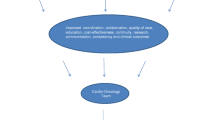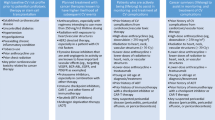Opinion statement
It is a fact that the field of Cardio-Oncology is growing rapidly throughout the USA and abroad. Cancer and heart disease continue to be the leading causes of death in the USA, and oncologic therapies are evolving to the point that cancer survivors are increasing yearly, some living long enough to develop cardiovascular disease, and others living with sequelae from their cancer therapy. The financial burdens to the healthcare system continue to present barriers for the delivery of healthcare, especially for patients with heart disease and cancer as chronic diseases. Collaboration between cardiologists and oncologists is paramount to ensure timely cancer care while minimizing cardiotoxicity. The field of Cardio-Oncology is the perfect model for the current management of these patients, positioned to break down silos, avoid delays in cancer care, and treating potential short- and long-term sequela of cancer therapy in a cost-efficient manner. While cardio-oncology programs initially sprang from the academic and defined cancer centers, it is rapidly growing in the nonacademic settings. This paper explores reasons that occurred and explores some of the unique aspects to cancer care and cardio-oncology delivery in the nonacademic setting. The ultimate goal is to achieve the best cancer care with the least degree of disruption to therapy that also minimizes cardiotoxicity, lowering costs, and improving outcomes for patients.

Similar content being viewed by others
References and Recommended Reading
Papers of particular interest, published recently, have been highlighted as: • Of importance •• Of major importance
WHO report: Global spending on health: weathering the storm. Accessed 11/8/21. https://www.who.int/publications/i/item/9789240017788.
Lenihan DJ, Cardinale DM. Late cardiac effects of cancer treatment. J Clin Oncol. 2012;30:3657–64.
Alexandre J, Cautela J, Ederhy S, et al. Cardiovascular toxicity related to cancer treatment: a pragmatic approach to the American and European Cardio-Oncology Guidelines. J Am Heart Assoc. 2020;9(18). https://doi.org/10.1161/JAHA.120.018403.
Keehan SP, Stone DA, Poisal JA, et al. National health expenditure projections, 2016-25: Price increases, aging push sector to 20 percent of economy. Health Aff (Millwood). 2017;36:553–63. https://doi.org/10.1377/hlthaff.2016.1627.
Accessed 10/22/21 at https://www.cdc.gov/chronicdisease/about/costs/index.htm.
Accessed 11/8/21 at https://www.cdc.gov/chronicdisease/about/costs/index.htm.
Accessed 10/2/2021 at https://www.healthsystemtracker.org/chart-collection/quality-u-s-healthcare-system-compare-countries/#item-start.
de Boer RA, Meijers WC, van der Meer P, van Veldhuisen DJ. Cancer and heart disease: associations and relations. Eur J Heart Fail. 2019;21(12):1515–25. https://doi.org/10.1002/ejhf.1539).
Koene RJ, Prizment AE, Blaes A, et al. Shared risk factors in cardiovascular disease and cancer. Circulation. 2016;133(11):1104–14 https://www.ahajournals.org/doi/full/10.1161/circulationaha.115.020406. Accessed Nov 2021
• Masoudkabir F, Sarrafzadegan N, Gotay C, et al. Cardiovascular disease and cancer: evidence for shared disease pathways and pharmacologic prevention. Atherosclerosis. 2017;263:343–51. https://doi.org/10.1016/j.atherosclerosis.2017.06.001 An important paper about shared risk.
•• Libby P, Sidlow R, Lin AE, et al. Clonal hematopoiesis: crossroads of aging, cardiovascular disease and cancer. J Am Coll Cardiol. 2019;74(4) An important paper summarizing some of the most exciting research in the field of Cardio-Oncology.
Siegel RL, Miller KD, Jemal A. Cancer statistics, 2018. CA Cancer J Clin. 2018;68:7–30.
•• Bluethmann SM, Mariotto AB, Rowland JH. Anticipating the “Silver Tsunami”. Cancer Epidemiol Biomark Prev. 2016;25:1029–36 Gives a unique perspective on numbers of patients at risk for cardiotoxicity, highly referenced paper.
Foot DK, Lewis RP, Pearson TA, Beller GA. Demographics and cardiology, 1950–2050. J Am Coll Cardiol. 2000;35(4):1067–81.
Shapiro CL. Cancer Survivorship. N Engl J Med. 2018;379:2438–50. https://doi.org/10.1056/NEJMra1712502.
• Falzone L, Salomone S, Libra M. Evolution of cancer pharmacological treatments at the turn of the third millennium. Front Pharmacol. 2018;9:1300. https://doi.org/10.3389/fphar.2018.01300 A most interesting historical perspective.
Mitchell JD, Cehic DA, Morgia M, et al. Cardiovascular manifestations from therapeutic radiation: a multidisciplinary expert consensus statement from the International Cardio-Oncology Society. J Am Coll Cardiol CardioOnc. 2021;3(3):360–80.
Bisceglia I, Canale ML, Cartoni D, et al. Prevention of chemotherapy-induced left ventricular dysfunction. European Heart Journal Supplements (2021) 23 (Supplement E), E28–E32 The Heart of the Matter, doi:10.1093/eurheartj/suab085.
Brown S-A. Preventive cardio-oncology: the time has come. Front Cardiovasc Med. 2020;6:187. https://doi.org/10.3389/fcvm.2019.00187.
Sadler D, Fradley M, Ismail Kahn R, Arnold A, et al. Florida inter-specialty collaborative project to improve cardio-oncology awareness and identify existing knowledge gaps. J Am Coll Cardiol: CardioOnc. 2020;2(3). https://doi.org/10.1016/j.jaccao.2020.06.009.
Peng J, Rushton M, Johnson C, et al. An international survey of healthcare providers’ knowledge of cardiac complications of cancer treatments. Cardio-Oncology. 2019;5(12). https://doi.org/10.1186/s40959-019-0049-2.
Accessed 11/12/21: https://www.thechristhospital.com/services/heart/specialized-care-and-treatment/cardio-oncology-clinic.
Sundlof DW, Patel BD, Schadler KC, et al. Development of a cardio-oncology program in a community hospital. J Am Coll Cardiol CardioOnc. 2019;1(2):310–3.
Arnold AM, Biga C. Implementing a cardio-oncology center of excellence: nuts and bolts including coding and billing. Cardiol Clin. 2019;37:545–57. https://doi.org/10.1016/j.ccl.2019.07.016.
Sadler D, Chaugalian C, Cubeddu R, et al. Practical and cost-effective model to build and sustain a cardio- oncology program. Cardio Oncol J. https://doi.org/10.1186/s40959-020-00063-x.
Fradley MG, Brown AC, Shields B, et al. Developing a comprehensive cardio-oncology program at a cancer institute: the Moffitt experience. Oncol Rev. 2017;11:340.
Alvarez-Cardona J, Ray J, Carver J, et al. Cardio-oncology education and training: JACC Council Perspectives. J Am Coll Cardiol. 2020 Nov;76(19):2267–81.
• Hayek SS, Ganatra S, Lenneman C, et al. Preparing the cardiovascular workforce to care for oncology patients. J Am Coll Cardiol. 2019;73:2226–35 Summarizes the ACC pathway to Fellowship training.
Adusumalli S, Alvarez-Cardona J, Khatana SM, et al. Clinical practice and research in cardio-oncology: finding the "Rosetta Stone" for establishing program excellence in cardio-oncology. J Cardiovasc Transl Res. 2020 Jun;13(3):495–505. https://doi.org/10.1007/s12265-020-10010-x.
O’Quinn R, Ferrari VA, Daly R, et al. Cardiac magnetic resonance in cardio-oncology: advantages, importance of expediency, and considerations to navigate pre-authorization. J Am Coll Cardiol CardioOnc. 2021;3:191–200.
Hester CA, Karbhari N, Rich NE, et al. Effect of fragmentation of cancer care on treatment use and survival in hepatocellular carcinoma. Cancer. 2019;125(19):3428–36. https://doi.org/10.1002/cncr.32336.
Stange KC. The problem of fragmentation and the need for integrative solutions. Ann Fam Med. 2009;7(2):100–3. https://doi.org/10.1370/afm.971.
Accessed 10/16/21 at : https://www.ama-assn.org/system/files/2021-05/2020-prp-physician-practice-arrangements.pdf.
ACC. Survey results and recommendations: addressing the cardiology workforce crisis. A Report of the ACC Board of Trustees Workforce Task Force September 2009. J Am Coll Cardiol. 2009;54(13):1195–208. https://doi.org/10.1016/j.jacc.2009.08.001).
Emerging Trends in Oncology Management: accessed 11/27/21 at: https://avalere.com/insights/emerging-trends-in-oncology-management.
Young KD. More and more doctors abandoning private practice accessed 11/27/21 at: https://www.webmd.com/health-insurance/news/20210527/more-and-more-doctors-abandoning-private-practice.
Accessed 10/16/21 from: American Hospital Association. Fast Facts on U.S. Hospitals, 2019. Chicago, Illinois: American Hospital Association; 2019. Available at: https:// www.aha.org/statistics/fast-facts-us-hospitals.
Fleishon HB, Itri JN, Boland GW, et al. Academic Medical Centers and Community Hospitals Integration: Trends and Strategies. J Am Coll Radiol. 2017;14:45–51.
Accessed 11/7/2021 https://www.cancer.gov/research/infrastructure/cancer-centers.
Accessed 10/16/21 at: https://www.thinkbrg.com/insights/publications/a-detailed-diagnosis-of-integrated-community-oncology/.
Accessed 11/7/2021 at: https://www.congress.gov/bill/97th-congress/house-bill/4961.
• Halcombe D. “The evolution of community oncology care and its threatened extinction due to federal and private payment reform,” American College of Medical Practice Executives; 2003. This article gives the reader insight into how the federal government with changing payment strategies and regulations can greatly affect how we deliver healthcare
Accessed 11/7/21 at https://www.ssa.gov/privacy/pia/MedicareModernizationAct(MMA)FY07.htm.
The Moran Company, cost differences in cancer care across settings (August 2013). Accessed 10/16/21: https://www.siteneutral.org/2013/08/17/cost-differences-in-cancer-care-across-settings-the-moran-group-august-2013/.
PQRS accessed 11/19/21: https://www.cms.gov/medicare/quality-initiatives-patient-assessment-instruments/pqrs/downloads/pqrs_overviewfactsheet_2013_08_06.pdf.
340B drug pricing program overview. Accessed 11/18/21 at https://www.340bhealth.org/members/340b-program/overview/.
Vandervelde A, Miller H, Younts J. Impact on Medicare payments of shift in site of care for chemotherapy administration. http://www.communityoncology.org/User-Files/BRG_340B_SiteofCare_ReportF_6-9-14.pdf. Accessed 18 Nov 2021
Winn AN, Keating NL, Trogdon JG, et al. Spending by commercial insurers on chemotherapy based on site of care, 2004-2014. JAMA Oncol. 2018;4:580–1.
Fisher MD, Punekar R, Yim YM, et al. Differences in health care use and costs among patients with cancer receiving intravenous chemotherapy in physician offices versus in hospital outpatient settings. J Oncol Pract. 2017;13:e37–46.
Hayes J, Hoverman RJ, Brow ME, et al. Cost differential by site of service for cancer patients receiving chemotherapy. Am J Manag Care. 2015;21:e189–96.
Mitchell AP, Kinlaw AC, Peacock-Hinton S, et al. Use of high-cost cancer treatments in academic and nonacademic practice. Oncologist. 2020;25:46–54.
Accessed 10/17/2021: Community oncology alliance: practice impact report. https://www.communi- tyoncology.org/2016-coa-practice-impact-report/.
Copur MS. Inadequate awareness of and participation in cancer clinical trials in the community oncology setting. Oncology (Williston Park). 2019;33(2):54–7 Accessed at: https://pubmed.ncbi.nlm.nih.gov/30784029/. Accessed 17 Oct 2021
NCI-NCORP: accessed 11/19/21 at https://ncorp.cancer.gov/about/
Copur MS, Ramaekers R, Gönen M, et al. Impact of the National Cancer Institute Community Cancer Centers Program on Clinical Trial and Related Activities at a Community Cancer Center in Rural Nebraska. J Oncol Pract. 2016;12(1):67-8, e44-51. https://doi.org/10.1200/JOP.2015.005736 Erratum in: J Oncol Pract. 2016;12(9):830.
Accessed 11/7/21: STANFORD https://stanfordhealthcare.org/second-opinion/overview.html.
Accessed 11/7/21: Moffitt https://moffitt.org/connect-to-a-healthier-you/cancer-expertise-in-a-day/?gclid=CjwKCAjwk6-LBhBZEiwAOUUDp6-kmjHy45SKyNqXfidPieyTguIhMUYnuwZkpvReVCf8VpXPatXtNRoCu0kQAvD_BwE.
Accessed 11/7/21: Memorial Sloan https://www.mskcc.org/news/how-do-get-second-opinion.
Accessed 11/7/21 MD Anderson https://www.mdanderson.org/publications/conquest/second-opinions-and-second-chances.h34-1591413.html.
Accessed 11/7/21 at Mayo Clinic https://connect.mayoclinic.org/champions/advice-on-second-opinions/.
Marij A, Hillen A, Niki M, et al. Patient-driven second opinions in oncology: a systematic review. Oncologist. 2017;22(10):1197–211. published online 2017 Jun 12. https://doi.org/10.1634/theoncologist.2016-0429.
Bodenheimer T, Sinskey C. From triple to quadruple aim: care of the patient requires care of the provider. Ann Fam Med. 2014;12:573–6. https://doi.org/10.1370/afm.1713.
Author information
Authors and Affiliations
Corresponding author
Ethics declarations
Conflict of Interest
Anita M Arnold declares that she has no conflict of interest. Kerry Skurka declares that she has no conflict of interest.
Human and Animal Rights and Informed Consent
This article does not contain any studies with human or animal subjects performed by any of the authors.
Additional information
Publisher’s Note
Springer Nature remains neutral with regard to jurisdictional claims in published maps and institutional affiliations.
This article is part of the Topical Collection on Cardio-oncology
Rights and permissions
About this article
Cite this article
Arnold, A.M., Skurka, K. Cardio-Oncology Care Delivered in the Non-academic Environment. Curr. Treat. Options in Oncol. 23, 762–773 (2022). https://doi.org/10.1007/s11864-022-00978-w
Accepted:
Published:
Issue Date:
DOI: https://doi.org/10.1007/s11864-022-00978-w




